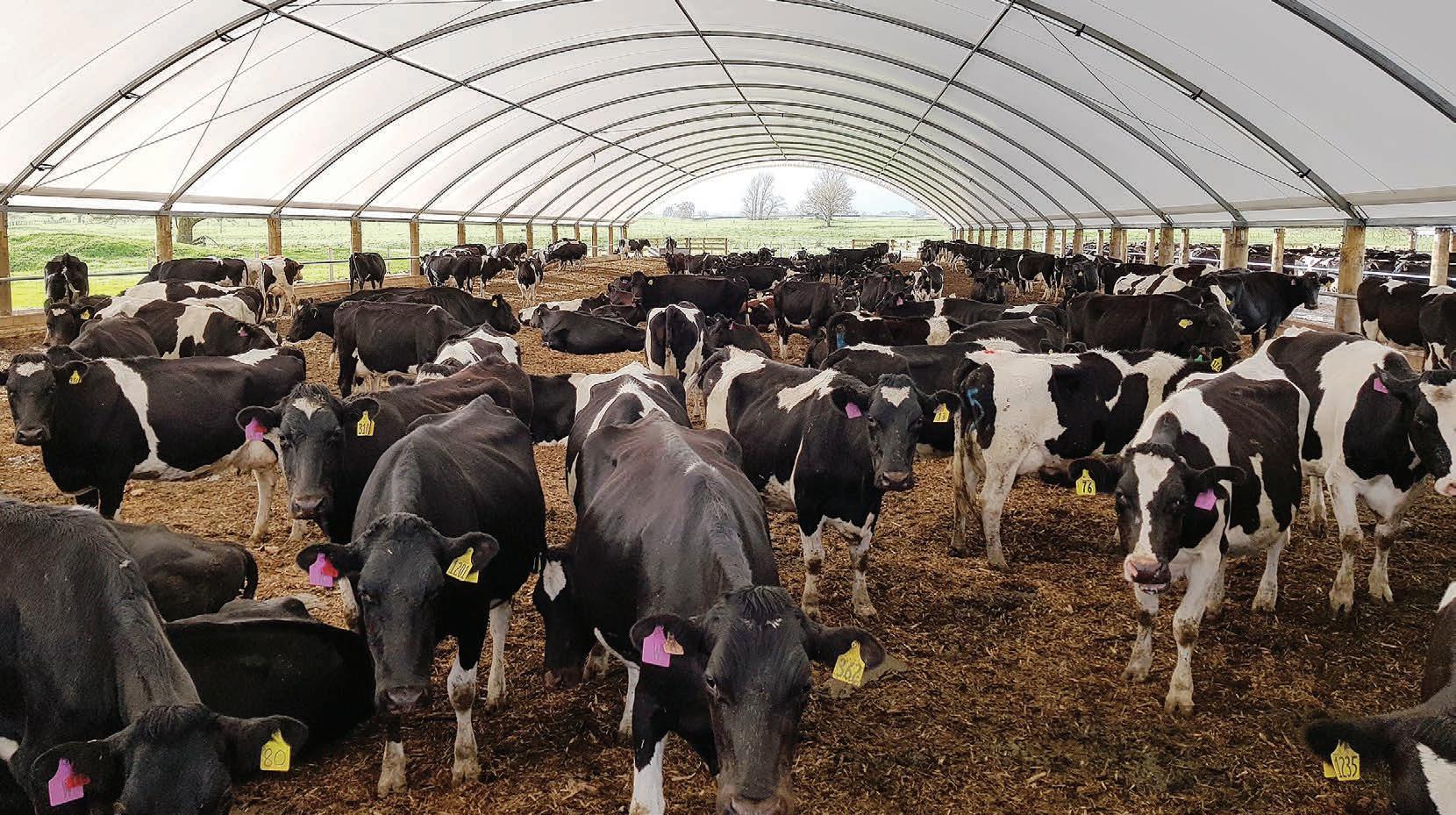
37 minute read
Effluent and summer management
from Dairy Farmer November 2020
by AgriHQ
One of three SmartShelter sheds on Martin Dairies at Morrinsville which are used mainly for the winter milk herd but also during summer to help keep cows cool.
A smart solution
By Cheyenne Nicholson
After making the decision to start winter milking a portion of his herd, Morrinsville dairy farmer Peter Martin and his son Shane Martin decided he needed to look at options that would enable him to feed his cows in winter and keep the
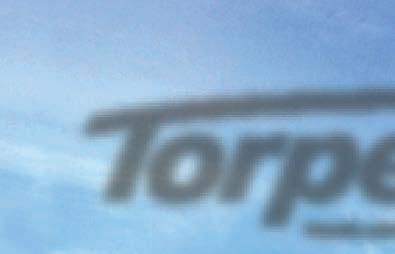

pressure off his pastures.
Peter and his wife Karen farm in an equity partnership with their son Shane and his wife Mel. With 1200 Friesian cows milked across three sheds on 300ha, the operation has scale, and they are always looking at ways to optimise their systems


to make the business as profitable as they can while ensuring cow and land health are the top priority.
“Pugging was the main thing on my mind when we decided winter milk,” Martin says.
“We obviously had the option of putting the cows in the cow shed yard at night, but I hated the thought of that, it was just asking for lameness issues. So, we started to look at shed options.”
They started winter milking a few seasons ago and now winter 450 cows with plans to increase that to 600 over the
coming season to have a split herd.
Finding a suitable option for standoff sheds, the Martins had a few things on their list they were looking for. Ease of effluent management was top of mind, along with how versatile it was.
Having looked at other options on the market, they settled on SmartShelters composting barns. The canvas roof barns are filled with postpeel.
“The sheds have feed bins on the outside, so we can fully feed the winter milking herd,” he says.
“We use the sheds in summer as well, as it gets them out of the heat.
“Other options we looked at had clear roofing, which made the sheds like hothouses in summer, so weren’t an option.
“The fabric does a great job of helping reduce heat stress in the summer.”
The Martins regularly achieve 10-12 degrees cooler temperatures in summer, which helps in increasing milk production through heat stress relief.
The farm is home to three of these sheds and they are predominantly used in winter for the milking herd and to on-off graze the remainder of the herd to alleviate pressure on pastures.
Each shed is 90m by 20m, and is replenished with postpeel at least once-a-year and cleaned twice-a-year. Cleaning involves taking a scraping off the top of the bedding, usually about 100mm, at the end of winter and again in March followed by a replenish of bedding.
“The bedding is about 600mm deep and because of the post-peel, the amount of effluent that comes out is very minimal, most is absorbed by the bedding and composted as it heats up, which keeps it dry for the cows,” he says.
“We also have a pipeline to the oxidation pond. Peel that comes out the shed goes out onto the crop paddocks and acts as a fertiliser.
“We’ve had far fewer incidences of lame cows through spring since having these sheds. They run to go into them because the bedding is so nice and they’ve got their feed right there.”
Peter says the biggest expense is the replenishing of the post-peel, which for them sits around $20,000 per shed. While this might put some people off, he says the benefits for their cows far outweigh the financial aspect.
“We have all our own gear, diggers and trailers and such, so that reduces costs. We had to do some number crunching when we made the decision to winter milk so much of this was factored in,” he says.
“Realistically, we couldn’t winter milk without these sheds; the cows love them and it allows us to manage the pressure on our pastures better year-round, but especially during the wet seasons.” n

Peter with grandson Olly and son Shane outside one of the sheds.

THE SMART CHOICE FOR A COMPOSTING BARN
Patrick Hunt Cambridge Dairy Farmer
An umbilical effluent system increases productivity by saving time as it has a discharge rate four times faster than a tanker system.

Benefits of umbilical effluent distribution
By Winston Smith
Effluent is something that every dairy farmer has to deal with, but instead of being seen as a problem, a change of focus can quickly recognise the positive effects it can have on the bottom line of your farming operation.
From feed pads to milking sheds, cows (and to a lesser extent, goats) can produce a lot of effluent, and there are a number of options when it comes to dealing with it.
In almost every case, effluent is collected in a storage pond or lagoon and can quickly build up so it needs to be kept under control. There are a number of ways of doing this.
Umbilical effluent systems provide a cost effective, efficient and environmentally aware method of distributing effluent into the pasture, where it provides very effective nutritional benefits, promoting grass growth and ensuring good feed for your stock, which then translates into good returns at the vat.
Unlike permanent built-in effluent distribution systems, which require a large capital investment upfront and can be location-restricted, umbilical systems are both budget-friendly and extremely mobile, as well as allowing a controlled spread of effluent in the paddocks.
Relatively new in the New Zealand dairy farming sector, umbilical effluent systems – and their benefits – are yet to be fully recognised, but we are seeing an increased uptake in their popularity as farmers and contractors start to become more aware of the positive aspects of the system.
Effluent is nitrogen-rich – rocket-fuel for pasture growth – and used effectively, can almost negate the need to bring in additional fertiliser from external sources.
It’s also completely organic, so provides a slow release of nutrients, allowing the soil to absorb all the goodness it has to offer. The result of that is rich, lush pasture, which provides great feed for your stock – and well-fed stock generates more milk and, importantly, better milk than those cows who are struggling to get the nutrients they need.
Because umbilical systems allow you to spread what you want, where and when you need it, you can tailor your effluent distribution to the requirements of your herd and your operation, as well as remaining environmentally-friendly by reducing the likelihood of it leaching into waterways, ponds and streams.
Using an umbilical system also goes a long way to reducing wear and tear on laneways, farm tracks and pasture because there’s no need to repeatedly run over them with a fully-loaded slurry tanker behind a tractor, which is also slow and inefficient.
What is an umbilical effluent system?
An umbilical effluent system pumps effluent from the storage pond to where it’s needed, even if it is severawl kilometres away.
By using a stirrer, the contents of the pond are agitated before being pumped through a large, flexible hose to a macerator unit on the tractor, which further liquefies any solids before running through a specialist spreader and dribble bar mounted on the rear of a tractor. The tractor then travels around the paddock towing the umbilical hose behind.
Such a system can discharge at least 200,000 litres per hour – a million litres a day is easily achievable – whereas a 20,000L tanker, averaging three loads an hour, would only manage 60,000L an hour.
One of the ways an umbilical effluent system helps you comply with environmental standards is through the design of its dribble bar. This uses hydraulics to give a consistent, measurable spread across the width of the bar. The system automatically records the amount of liquid spread, when it was spread and where, giving
you proof of placement should regulators require it.
The dribble bar also minimises odour and wind drift and ensures a more efficient uptake of nitrogen by placing the effluent directly on the ground, rather than spraying it into the air.
An umbilical effluent system increases productivity by saving you time. It has a discharge rate four-times faster than a tanker system, which gives you the option of picking and choosing when best to empty the storage pond depending on weather and paddock conditions. Also, the umbilical pipe can take a more direct path to where the effluent is needed, rather than being constrained, as a tanker is to follow a designated roadway, which would add distance and time to the turnaround.
Another key benefit of an umbilical effluent system is the money to be saved by reducing traffic and load weights on pasture and races. A fully-laden 16,000L tanker and tractor weighs about 32 tonnes, whereas a tractor and spreader carrying reels of hose weighs about 12t. Where more than one tanker is working on a site, there are safety issues as well – tractors having to pass each other by pulling over to the edge of narrow tracks, for example.
The lighter weight of a tractor and umbilical hose also considerably lessens soil compaction, which helps reduce water runoff and increase crop yield. Gateways, in particular, reap the benefits. These soon become damaged from tankers coming and going, whereas an umbilical system goes through the gate only twice – once in and once out.
Effluent management is something a lot of farmers don’t want to think about, but ignoring it won’t make it just go away. Every farm needs an effective and well-designed effluent management An umbilical effluent system pumps effluent from the storage pond to where it’s needed, even if that is several kilometres away.
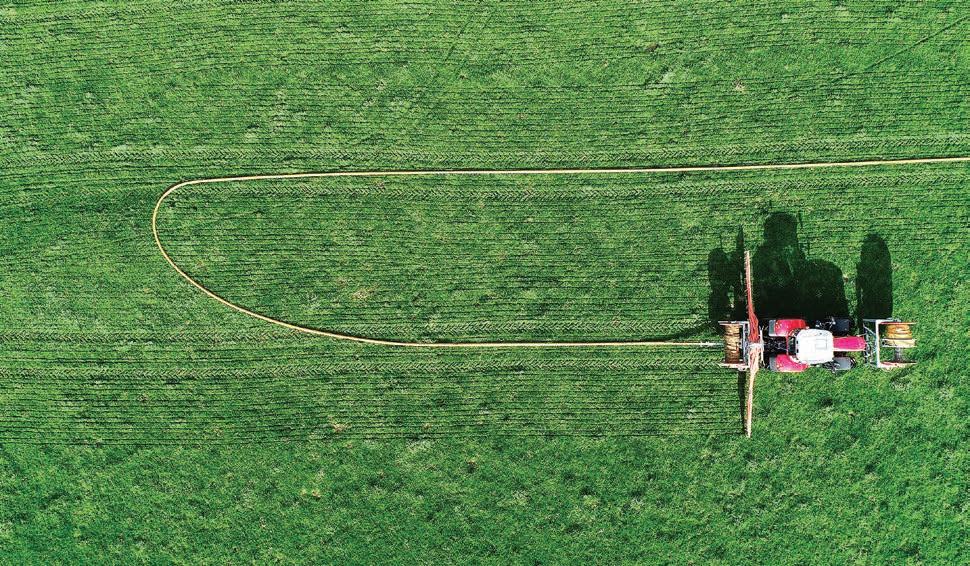
Farmers need an effective and well-designed effluent management system to help them with compliance.
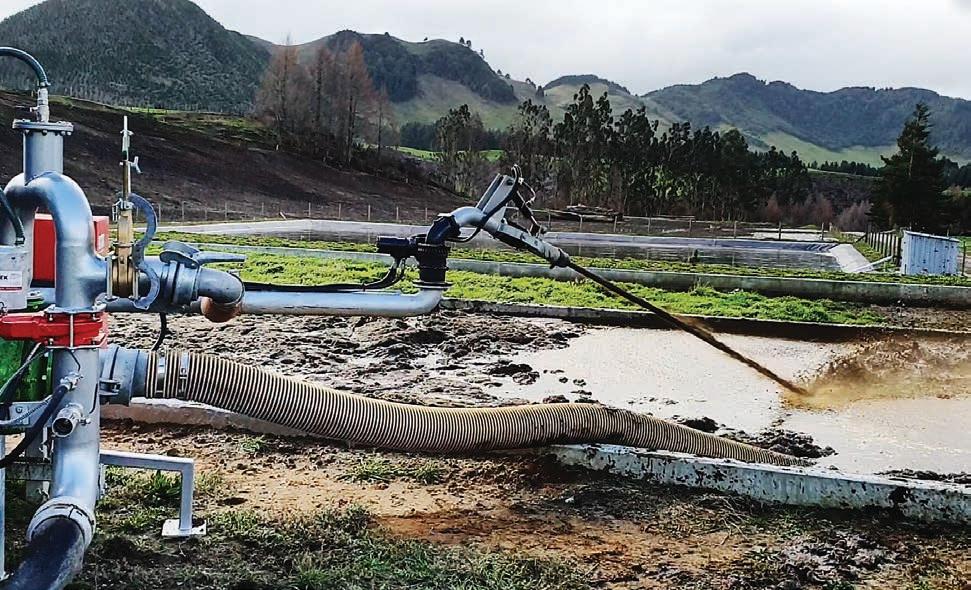
system and umbilical effluent spreaders are certainly an option worth exploring for new systems, or even as an upgrade to an existing operation. n MORE: Winston Smith is the effluent management expert for Webbline Agriculture.
DAIRY BUSINESS OF THE YEAR ON-FARM FIELD DAYS
DBOY is proud to host a series of Regional Optimisation Days during November 2020.
Held on the DBOY 2020 Regional Winners’ farms, these field day events are a great day out and an excellent opportunity to hear and learn from some of New Zealand’s most resilient, sustainable and innovative dairy farmers. n Thursday 5 November
LOWER NORTH ISLAND
n Tuesday 10 November
NORTHLAND
n Wednesday 18 November
CANTERBURY
n Tuesday 24 November
WAIKATO
For more information visit www.DBOY.co.nz

your liquid gold.
The system is becoming increasingly popular with farmers doing their own effluent spreading or for contractors servicing the needs of their farming clients.
Fifth-generation farmer Louis English and his wife Angela milk 850 cows on a 335-hectare family farm at Dipton West, Southland.
They have employed an umbilical spreading operation on their farm to help cope with an increase in effluent since their wintering barn was put up about six years ago.
“We used contractors for the first two years with mixed results, and it was interesting to see the different set-ups they used,” English says.
“We did the numbers and worked out it was going to be more efficient and effective to use our own gear and ended up purchasing an umbilical system with a nine-metre dribble bar and 1600m of hose.”
They run a tanker in their operation as well, but didn’t like the number of trips that it would have taken them to empty the pond, and worked out it would end up taking nearly 500 trips to and from the paddocks.
This, obviously, would heavily damage the lanes and I didn’t want Southland farmers Louis and Angela English use the umbilical effluent system with a nine-metre
Umbilical system simplifies effluent spreading
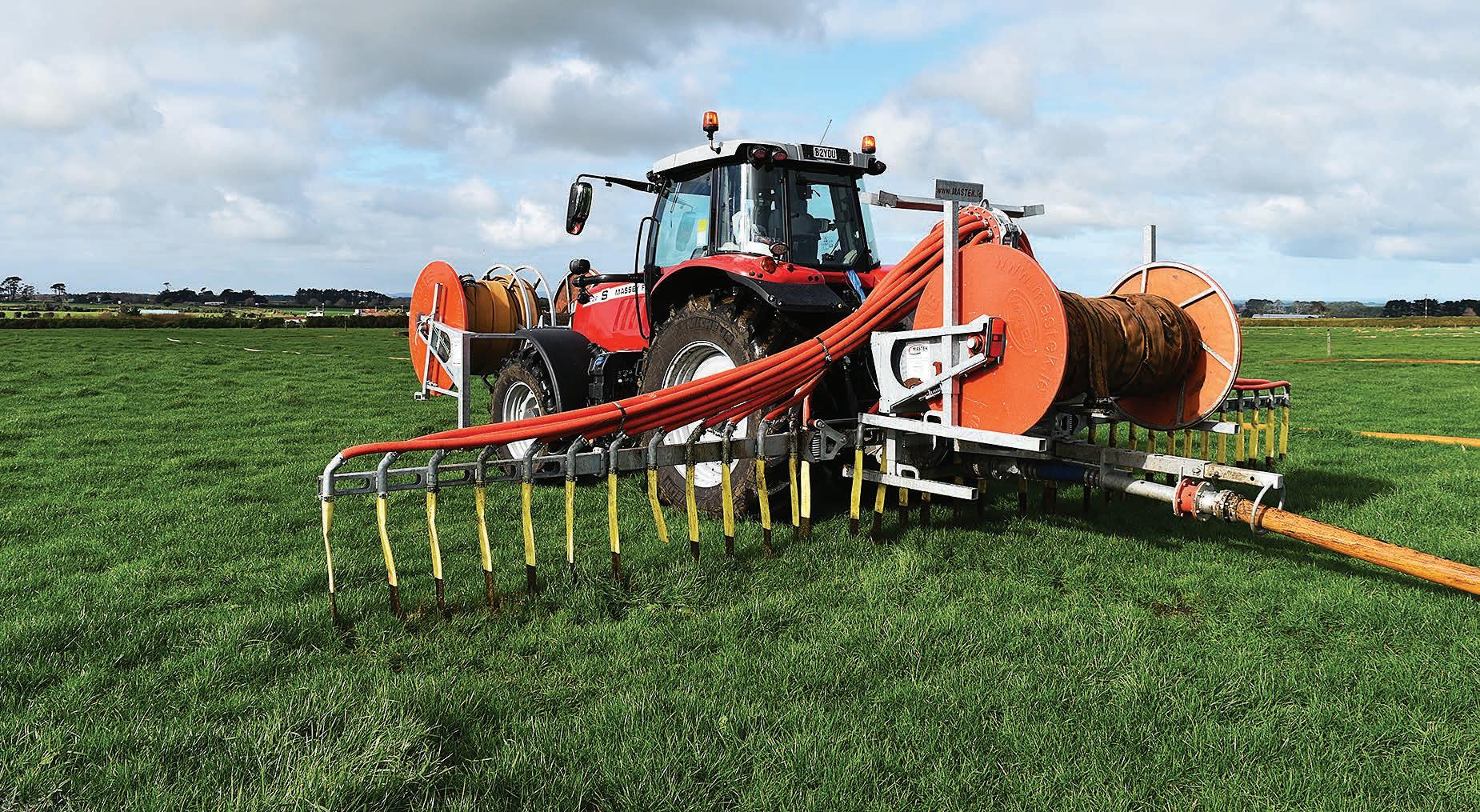
The Mastek Umbilical System from Webbline offers a safe, environmentally-friendly and efficient way of disposing of
dribble bar such as the one shown. to see this happening,” English says.
“We found it a lot easier to go into a paddock once, do the spreading and go back out instead of going in and out multiple times with the tanker.
“We had issues at the start from the tanker splash plate giving too much grass cover contamination, which meant the cows weren’t eating the grass for a long time afterwards. The dribble bar gives us less leaf coverage and, therefore, a lot quicker turnaround.”
The English’s generally pump around 200,000 litres per hour and have found that you can definitely see the grass growth where they have been in with the dribble bar compared to other areas of grass.
“It is a lot more straight-forward to operate than it looks at the start; you just need a plan on how to get around obstacles and oddly-shaped paddocks,” he says.
“With the flow meter in the cab,
Running out the hose which has a reach of several kilometres and can be easily reeled back in.

you can pace yourself for optimum application with the schedule supplied by Webbline, which shows the speed needed for the correct rate of application.”
They run the dribble bar on a 150hp tractor in the paddock, and the pump tractor is a 160hp unit, which makes things very easy and efficient to operate.
The system offers pond stirrers and lagoon mixers that have a hydraulic control multi-directional mixing nozzle, ideal for breaking up thick crust and capable of mixing large lagoons from one location.
They use a Bauer pump system that The Mastek umbilical effluent system is safe and environmentally-friendly and a good solution for farmers wanting to spread effluent over the farm themselves.

comes in a variety of tractor driven configurations or a self-propelled engine drive. These are capable of pumping up to 300m2 of slurry per hour to the dribble bar. These come with a working width of either 9m or 12m. These are designed to allow the precise application of slurry to grassland and crops with minimal disturbance and are specifically designed for use with umbilical drag hose systems to optimise hose labour and enable precise distribution. n
Are you looking for new or used farm machinery? We’ve got the wheels in motion!
Two iconic New Zealand rural publishing brands Farmers Weekly and Farm Trader, have partnered to connect more farmers with the latest in new and used farm machinery, technology and products.
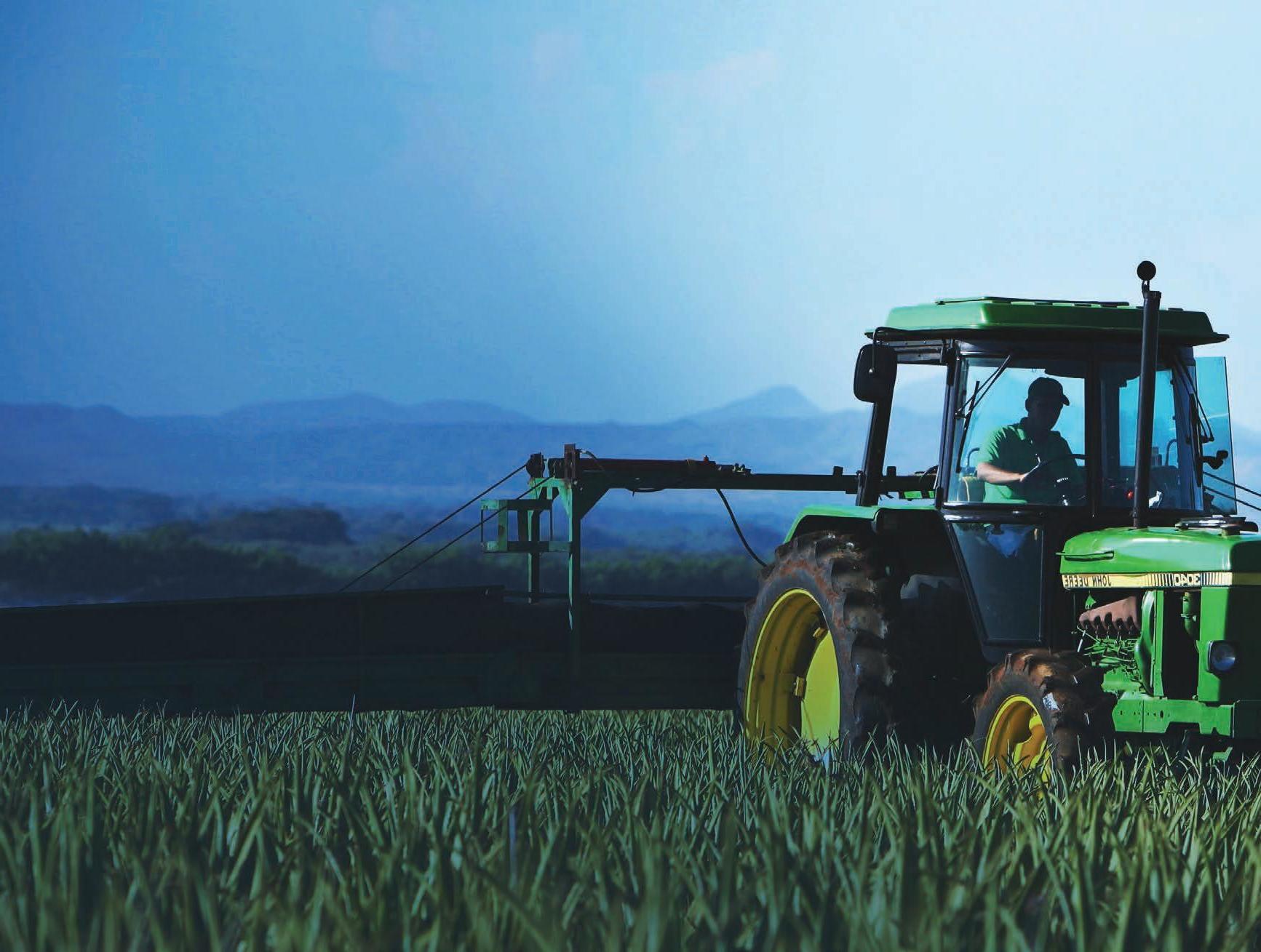

This partnership will enable companies to showcase their machinery and farm products in an agile way, any week of the year - look out for it in your letterbox.
If you are interested in finding out more, contact your partnership manager today.

Optimising effluent use on-farm
With the changing landscape of New Zealand farming, it’s more important than ever that dairy farmers have all their processes in order to meet the high standards that define our primary sector.
Nutrient management is a key area and it has become a very precise process so that pasture and animal response is optimised, soil health is maintained and waste is minimised. Productive, sustainable farms with a light environmental footprint is the goal.
Part of the nutrient management process is making sure farm dairy effluent (FDE) is handled appropriately for the farm system and within approved rules.
Effluent has historically been viewed as a waste product to get rid of, but in fact is a valuable source of nutrients. It is now commonplace to spread FDE on to land using designated blocks for application. Those blocks are included in nutrient budgets that model potential losses to the environment based on the area receiving the effluent.
Over recent years, researchers have also shown that FDE can be well-utilised on cropping paddocks that are part of the dairy platform. Paddocks, which have a long history of effluent application, may have a large bank of nutrients in the soil which have yet to be utilised.
Dairy effluent, depending on its treatment, can be particularly high in nitrogen and potassium, which makes it an ideal fertiliser for maize crops for instance. Deep-rooting crops such as maize, can mop-up the stored nutrients in effluent paddocks, thus recycling these valuable nutrients to other parts of the farm when fed-out and therefore reducing potential leaching losses.
It is important to understand that the nutrients in effluent applied to land tend to be in a slow-release form, with only 50% of the nitrogen and phosphorus available in the first year of application (potassium is almost all available). For this reason, it is likely that in repeatedly cropped paddocks additional fertiliser nutrients will be needed for some crops.
Farmers may have limited insight on the nutrient composition of effluent being applied, which can change through the season depending on the type of feed in the cow diet and also the time of year.
Testing your dairy effluent’s nutrient composition is a crucial step to optimise effluent use and should be done a few times per year due to these seasonal variances.
Effluent testing should be seen as an important part of nutrient management along with soil and pasture testing. The more nutrients that can remain on-farm, the more value will be retained by the farmer and the better it will be for the environment.
Unless the effluent is measured for its nutrient content, the application rates of nitrogen can only be calculated using assumptions of the effluent composition. This may lead to over application of nutrients, resulting in non-compliance and potential environmental risk.
Hill Laboratories – New Zealand’s largest privately-owned analytical testing laboratory – have led the way in analytical testing for many years using the latest technology and methods.
Hill Laboratories makes it easy to do a regular testing programme, with their DIY Dairy Effluent Sampling Kit that can be ordered online. The system is a quick, easy-to-use and convenient way to order tests and sampling supplies. For registered users, the online system automatically remembers favourite tests – making life much simpler.
Effluent test results are reported for dry matter percentage and the total nutrients of nitrogen, potassium, phosphorus, calcium, magnesium and sodium. A worked example for two different application depths to give N, P and K as kg/ha are also provided in the test report.
For crop soils, an additional test request for the more readily plant-available forms of nitrogen (NH4-N and NO3-N) is recommended. This can be important because, as identified, the nutrientrelease rate from FDE can be variable.
Your effluent test results can be used in conjunction with soil tests to guide
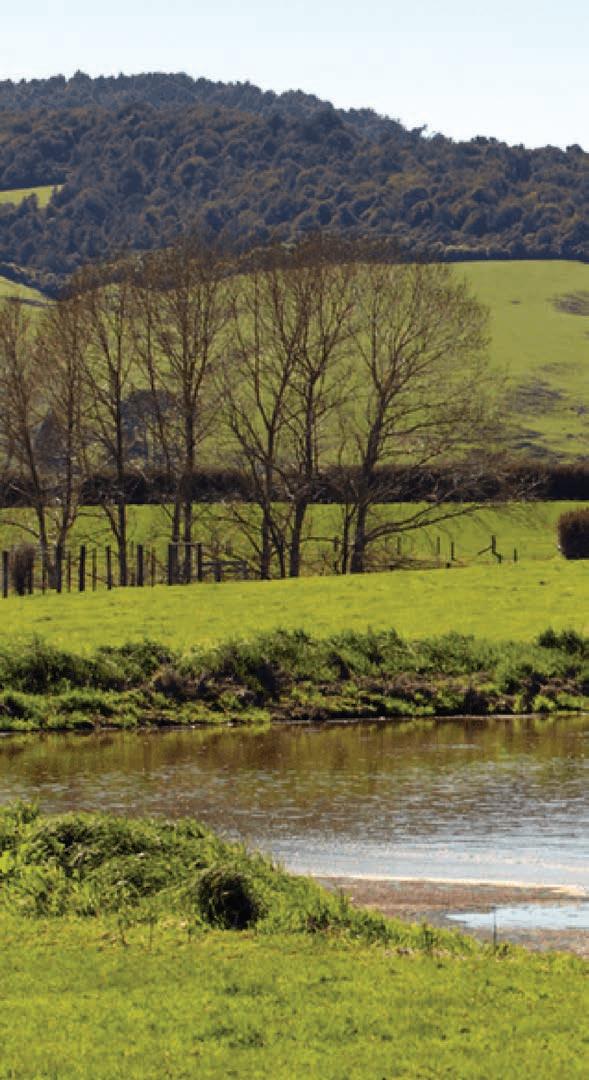
fertiliser decisions with the help of certified nutrient advisors. For instance, whether fertiliser can be withheld from the effluent block, or how much additional fertiliser may be needed for targeted crop yields.
Analysis of farm dairy effluent makes sense for multiple reasons: from a nutrient resource point of view and as a means of keeping nutrient-loading rates within regional regulatory frameworks.
Trust the NZ-owned laboratory with methods developed specifically for our unique conditions, and proven systems, for fast, accurate results. n
WHAT’S BETTER THAN A NEW WATER MONITORING SOLUTION?
A solution that’s made in NZ.
See the Water Flow Indicator in action:
Available now at your local farm supplies store.
Dairy effluent, depending on its treatment, can be particularly high in nitrogen and potassium, which makes it an ideal fertiliser for crops.
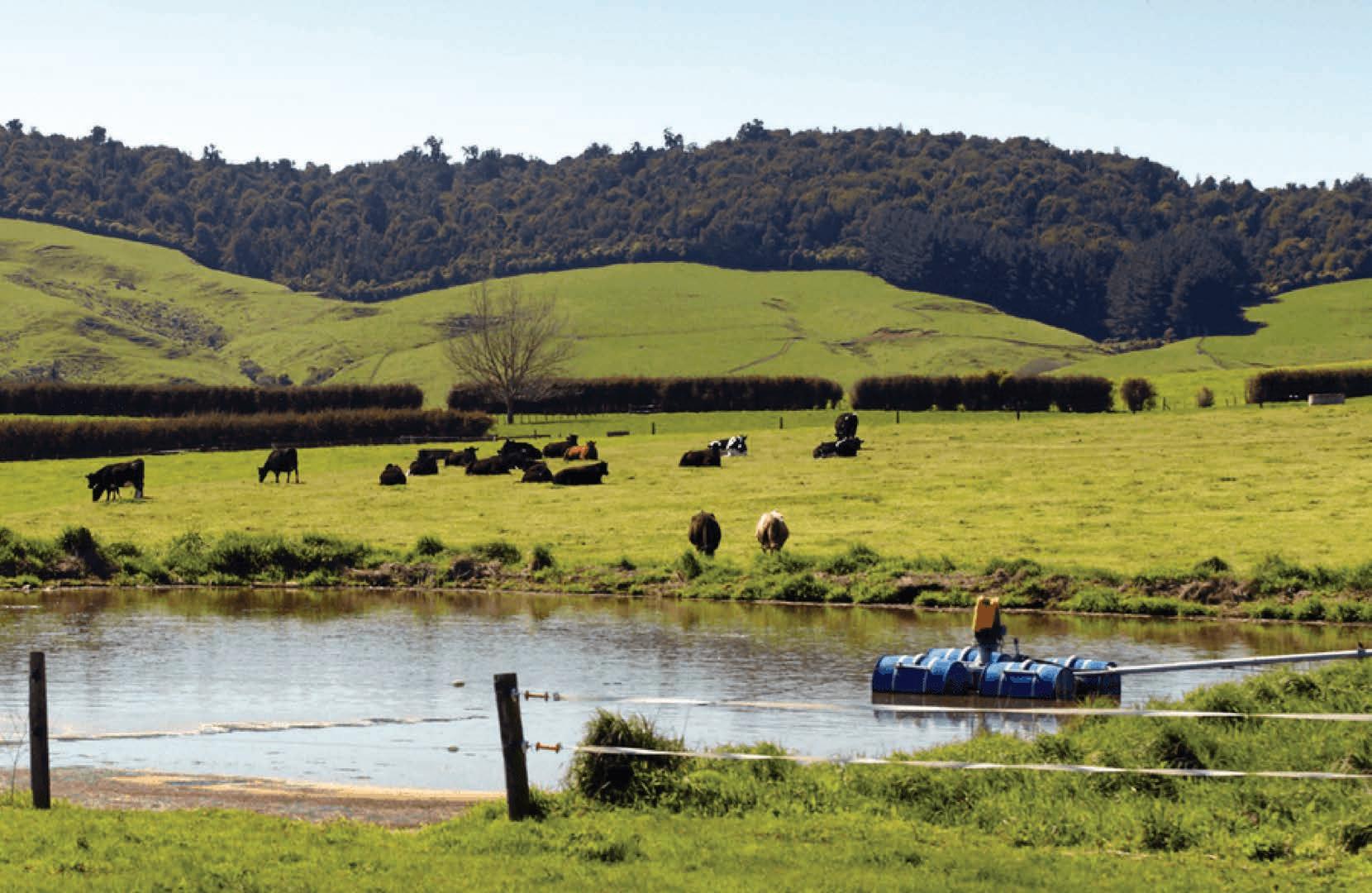
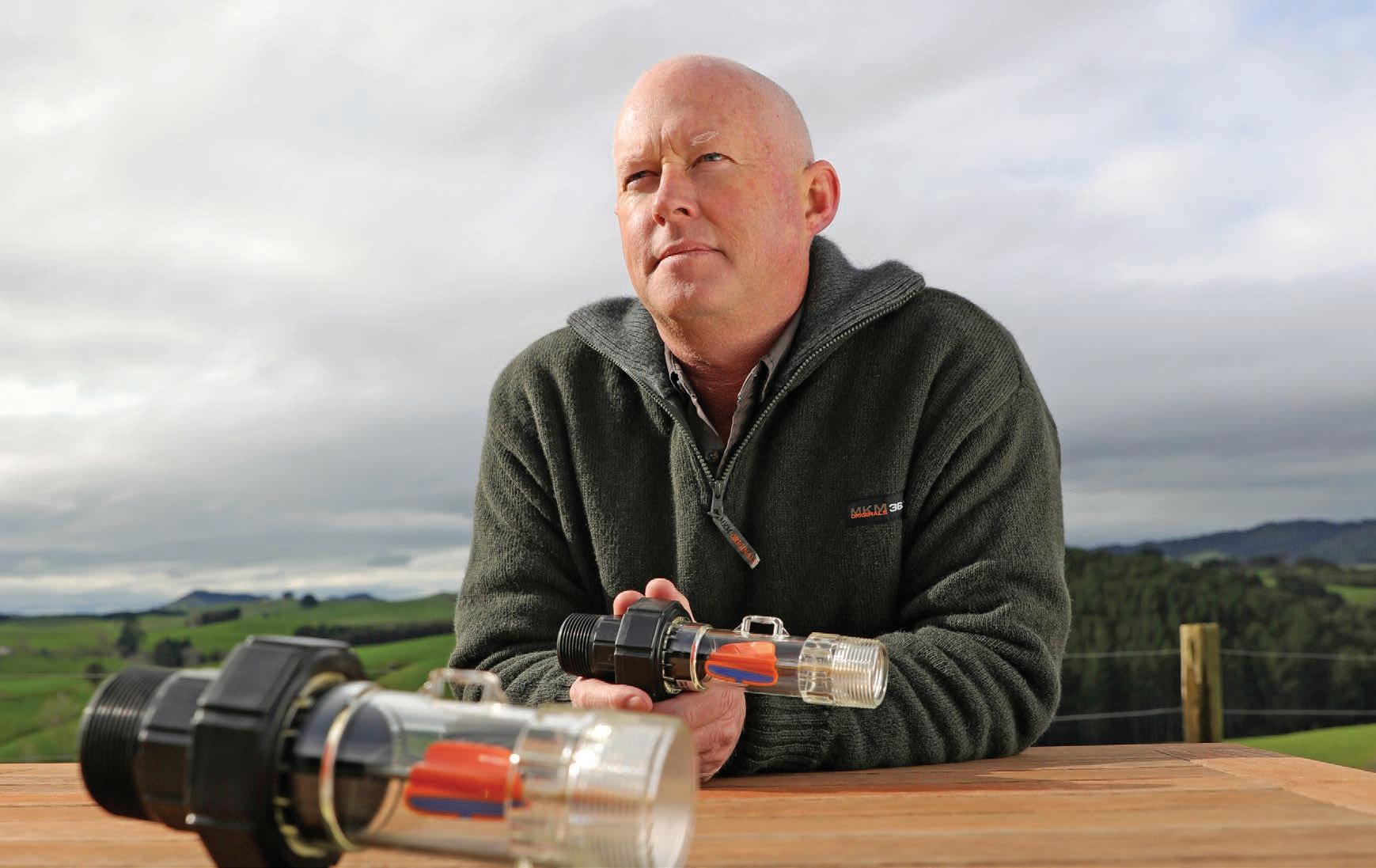
Murray Jones Farmer and inventor “I invented this solution to find water leaks faster and I chose to partner with a trusted NZ company who can build the product here. For me NZ Made means high quality, built for purpose and ethically made. Kiwi farmers deserve nothing less.”
Rebalancing NZ farms with dung beetles
As the agricultural industry grows and farmland usage is being intensified, more than 100 million tonnes of cattle, sheep and horse dung piles up every year. The run-off from this dung is steadily degrading our waterways, while the residual mess is infecting our animals and impoverishing pastures.
Andrew Barber and Dr Shaun Forgie are driving the rebalancing of New Zealand’s farming system and say the solution is right under our feet – dung beetles.
Dung beetles offer a remarkable natural sustainable solution to revitalise soils and pastures, and can rehabilitate New Zealand’s waterways in as little as 23 years – if we act now.
Inspired by their desire to see the dung beetle improve NZ’s soils and waterways, the pair have established Dung Beetle Innovations as a commercial enterprise and want to see as many farmers as possible enjoy the benefits provided by dung beetles.
So far, about 350 farmers have released more than 1000 dung beetle colonies the full-length of the country.
Barber project managed the Dung Beetle Release Strategy Group, an MPI farmer-led project to import dung beetles into NZ, while Forgie, an internationally recognised entomologist, was the lead scientist for the project.
There are 11 species allowed in NZ with seven presently being mass reared at the world’s largest dung beetle breeding facility in Auckland.
Forgie matches the species to the type

The bright paua coloured spiniger is active in late summer.
of farm they will be released on and gives advice on where to release them, which is very easy to do.
Barber says raising dung beetles is like planting trees.
“It takes two or three years to get established. Then by about year five, there is a noticeable population. Around year nine, they are at the farm’s carry capacity and start fanning out,” he says.
He says for a one-off cost of $6000, the average-sized farm dung beetles will bring multiple benefits to a farm and pay for themselves in greater farm productivity and improved water quality.
The benefits include: • Increased aeration of the soil allowing Copris hispanus is active in autumn to early spring.
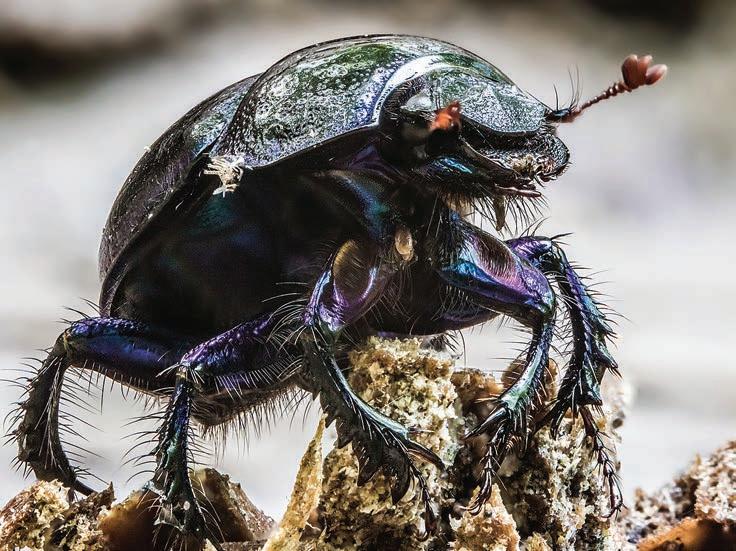
water to penetrate better, resulting in increased grass growth. Enhanced forage palatability. Reduced run-off and better retention of dung and urine in the soil. Reduced infection of livestock by parasitic worms. Reduced fly pests and human disease. Increased soil carbon. n
MORE: To see dung being destroyed in less than 24 hours from a ferocious attack of dung beetles, go to DBI’s website and select videos from the menu. For more information go to www. dungbeetles.co.nz
Know Your Catchment goes live
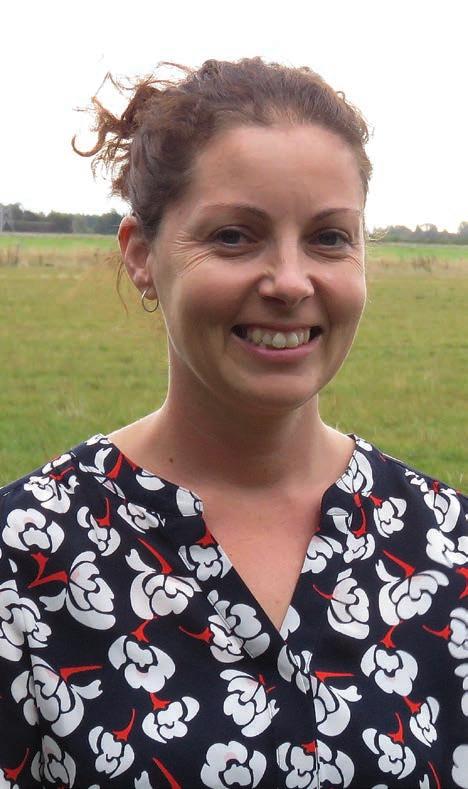
By Gerard Hutching
IrrigationNZ has launched a pilot online platform that offers up-to-date information about freshwater in the Waitaki River catchment.
As yet, the Know Your Catchment platform is restricted to the Waitaki River catchment in South Canterbury-North
Otago, but there is a possibility it might go wider.
“It depends on the resources and interest,” IrrigationNZ’s regional policy and planning manager Elizabeth Soal says.
“There is one catchment in the North Island and another in the South Island which have expressed interest.
“This platform will engage and educate both rural and urban communities about the commitment farmers and growers have made to maintaining and improving water quality with information about water quality, irrigation, recreation, wetlands and more.
“Given the public feeling about water quality, farmers and growers need to openly demonstrate the practice change that is happening and all the robust environmental monitoring data needs to be consolidated in an easy-tounderstand way – which is what Know Your Catchment does.”
Besides showing water monitoring data, the platform contains stories about catchments – for example, the riparian planting that is being done.
Soal says farmers and growers were doing a lot of monitoring in their catchments and bringing this data together to tell the catchment story was important.
Comparing it to the Land Air Water Aotearoa (LAWA) website, she says the LAWA information was collated by regional councils, which could take some time, whereas this information was more recent.
“It’s more up-to-date and also more fine grained, with more sites. Some of the LAWA data was collated a year to 18 months beforehand, whereas ours is a few weeks,” she says.
“It’s also about building information over time, not just the data, but qualitative information about what’s happening in the catchment, projects that are going on and significant events.”
In future, it might contain water use data and information from irrigation schemes.
The portal was targeted towards the

IrrigationNZ’s regional policy and planning manager Elizabeth Soal says the new online platform Know Your Catchment will engage and educate both rural and urban communities about the commitment farmers and growers have made to maintaining and improving water quality.
community at large and for farmers with the idea that it might show up trends or hot spots in water quality so that farm environment plans might address specific issues.
Work on the platform started in 2018.
While the pilot has cost $180,000, Soal says a lot of that was initial scoping and she did not expect further rollouts to cost as much. She would not name the regions which had expressed interest in having it for their catchment.
The pilot has been funded by the Ministry of Primary Industries Sustainable Food and Fibre Futures Fund and managed by IrrigationNZ in partnership with Waitaki Irrigators Collective, Otago Regional Council and Environment Canterbury and supported by Beef & Lamb NZ and the Foundation for Arable Research. n
Low pressure effluent spreading systems or a travelling irrigator allow more nutrients to get into the ground for pasture.
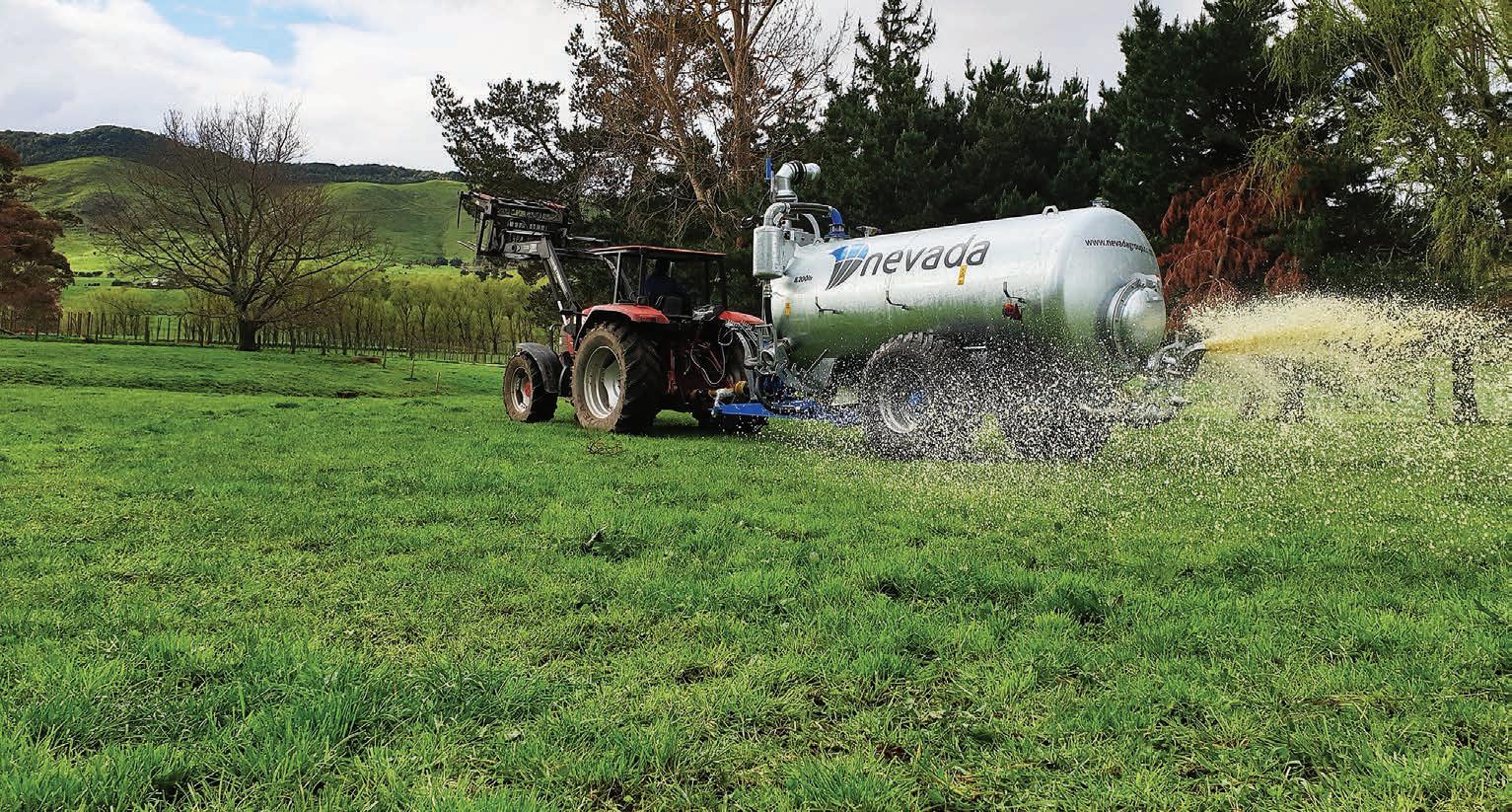
Strategies for effluent management
When choosing effluent storage go for a HDPE lined effluent pond and to get the best result from spreading your nutrients, it’s always recommended you give the pond a good stir first.
By Lloyd Thomas
Acost effective effluent management system is what we’re all aiming for right? After all, effluent management is all about the effective utilisation of nutrients.
What is a cost effective effluent management system? It’s one that gives you maximum benefit from your investment. We see this as a system that is: • Future-proofed – so you’re not worried about major upgrades and changes in the near future. • Simple and efficient – designed for maximum results from minimal resources. • Reliable – well planned and executed using tools and equipment that suit your farm’s set up, so you’re not having to deal with constant hiccups.
Below are five of the most cost effective strategies for dairy effluent management systems.
1. Minimise processing with gravity
From the milking shed to storage, you want to minimise processing. The most efficient method is to have all your effluent draining by gravity into one single storage facility.
How is this cost effective? Well, having your milking shed located slightly higher than the effluent storage pond allows the effluent to run naturally into the pond – no need for double pumping or extra work in solids separation. This setup will save you time, labour and energy costs.
2. Lined effluent ponds
When choosing effluent storage, where possible go for a HDPE lined effluent pond. Why? • Ponds are the cheapest storage option to implement, with digging and lining being a fraction of the cost of an above-ground tank. • HDPE lined ponds require little maintenance, and the lining is designed to last over 100 years – now that’s future-proofing, • Council compliance – with a HDPE lined pond you’re unlikely to experience waterway leeching, so it’s easy to get the big tick for council compliance. • Fitting other effluent equipment or fitting in with existing effluent equipment such as effluent stirrers and pumps is easy, as most ponds don’t require special equipment to be fitted. • Lined effluent ponds are by far the most common method of storage within the wastewater industry.
3. Stir well
To get the best result from spreading your nutrients, it’s always recommended you give the pond a good stir first. But what makes a good stir?
Aim for a shore mounted stirrer with a Typhoon propeller. • Shore mounted stirrers create a near horizontal flow, which gets the whole pond swirling, resulting in a homogenous mixture. • Shore mounted stirrers have the most efficient use of power – they get the job done faster and more effectively. • A Typhoon propeller is specially designed to produce a strong trust, which is what’s needed to effectively churn through all the usual stuff found in an effluent pond without splashing.
4. Positive pumping
A positive displacement pump is the way to go for cost efficiency. The beauty of these pumps when it comes to managing effluent are: • They are great for maintaining pressure and volume, so you’ll get a consistent flow being pumped through for spreading. • They use a smaller motor to achieve the same results/output, so you’ll be using less energy to get the job done in the same amount of time. • Since they pump more consistently with pressure and volume, they are better able to overcome friction in the pipelines regardless of distance or elevation.

5. Use low pressure
To make the most of your effluent nutrients, it’s best to use a low pressure spreading system. Low pressure effluent spreading systems, such as a drag hose system or traditional travelling irrigator, cause less volitisation than high pressure systems, meaning more nutrients make it to the ground available for pasture to drink.
For even smarter spreading and faster pasture growth, add a natural liquid fertiliser like AddGreen to your effluent before spreading with a RainWave slurry tanker. AddGreen is specially formulated Low pressure effluent spreading systems or a travelling irrigator allow more nutrients to get into the ground for pasture.
to utilise the nitrogen you are able to spread, creating a more balanced nutrient application – you’ll get more bang for your buck while making the most of your time spent spreading.
Lloyd Thomas is a member of the Customer Solutions Team at Nevada Ltd.
SUCCESS STORY Alan’s farm is now odour free! Alan & Conny Bull Dairy Farmers - Kaiaua
Alan’s keeping everyone happy with his improved effluent management...
Alan and Connie Bull have two dairy farms in the Kaiaua area, milking approximately 300 cows...
Alan’s always been an advocate for utilising effluent for fertilisation, and he already had a small electric pumping system with irrigator set up to spread over the close paddocks. The problem Alan wanted to solve was being able to spread over all the paddocks without it taking up too much time and labour. Mike visited the Bull’s farm to find a solution... “The pumping system Alan has set up works well for those closer paddocks, but with having two farms the best solution is to have a slurry tanker that can cart the effluent wherever it’s needed. The auto-fill option makes the job a lot faster, easier and less messy, and the tanker’s something anyone can operate as long as they can drive a tractor.” Michael Prestidge, Nevada The Nevada MB80 single axle slurry tanker is ideal for the farm’s hilly terrain, and as an added bonus, the new tanker has solved some other issues too...
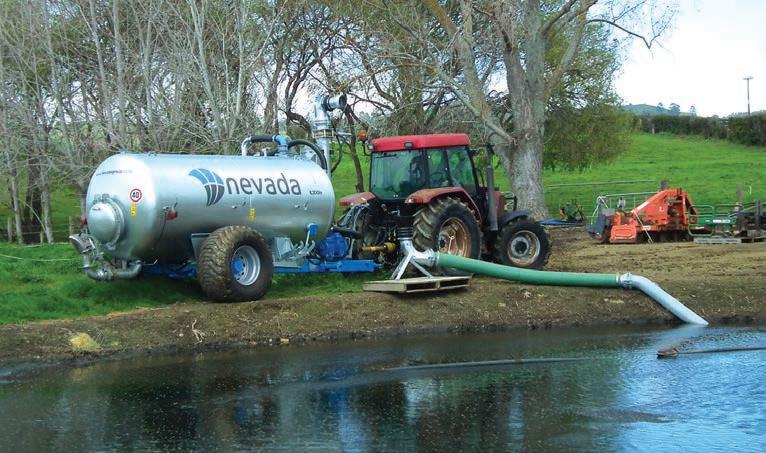
“It makes a quick job of spreading to the other paddocks we weren’t reaching before, but the thing I’ve really noticed is how little wind drift or smell there is. Now we can keep everyone happy!” Alan Bull, Dairy Farmer
Drenching key to healthy cows
By Anne Boswell
With dairy calf weaning just around the corner, it’s time to set an animal health plan into motion that will support calves to reach their potential in both health and productivity or growth.
A key part of that plan is worm and parasite control, which begins at weaning when calves are at risk of developing coccidiosis, an intestinal disease.
Coccidia are protozoan parasites that are passed on through the faeces of infected animals. Calves pick up the disease through contaminated pasture seeded with coccidial oocysts, feed and water, or by grooming each other.
Clinical coccidiosis can cause blood and mucous stained faeces, as well as weight loss or low weight gain, with possible anaemia and mild diarrhoea.
Long-term, coccidiosis can cause damage to the intestinal tract and have long-term effects on the growth rates and productivity of the animals that survive.
While calves are being fed milk and meal in the calf shed, there is no need to offer any protection against these challenges as calf meal generally contains a coccidiostat that suppresses coccidia.
However, meal-fed calves lack the opportunity to build natural immunity against the parasite and an outbreak of coccidiosis often occurs around four weeks after the first calves leave the calf shed.
And later in life, the effects of uncontrolled parasites or worms can be seen as losses in animal productivity, lower milk production and low conception rates, all of which have major economic consequences.
Alleva Animal Health general manager Blair Loveridge says farmers understand the importance of establishing a robust parasite control plan, but can encounter several pain points that reduce the simplicity of their drenching systems.
“When speaking to farmers we found that some of the existing combination products on the market had weight limitations, meaning farmers had to use different products within one mob due to variation of growth rates,” he says.
“Another concern was the transition of calves from meal to pasture without any protection against coccidiosis.”
Loveridge says Alleva’s Turbo threestage drench programme was created to simplify drenching, giving farmers a programme to work through with their vet and target parasites at specific stages of growth.
The oral drench is specifically designed for weaned calves, providing worm parasite coverage as well as helping to protect against coccidiosis. The worldfirst combination bridges the gap between calves coming off coccidiostattreated meals onto pasture when their natural coccidiosis immunity has not yet developed.
“To be able to provide farmers with one product that meets their needs in terms of worm control as well as coccidiosis coverage for young stock is massive,” Loveridge says.
Turbo Advance is an oral drench that targets cattle in the second stage of growth, protecting against internal parasites and providing them with trace elements within a high potency, widemargin-of-safety formula.
When cattle reach the third stage of growth, Turbo pour-on or injection provides parasite worm control with the DMI-Sorb™ rain-resistant technology created by Alleva to meet New Zealand’s unruly weather conditions.
Along with parasite coverage, the company has invested heavily in ensuring this programme also meets other requirements for farmers, including using active ingredients that are high potency and provide a wide margin of safety when treating cattle.
“Farmers have enough to do without Alleva keeps New Zealand farmers’ needs in mind when designing new formulas for drenching stock. Their Turbo Initial is a world-first formula for coccidiosis and parasite protection in weaned calves.

worrying about the perfect drench programme,” he says.
“The result of listening to their concerns is a cattle drench system that is a huge leap forward in terms of efficacy and safety.
“Gastrointestinal worms can be difficult to control if they become resistant to drenches. High potency ingredients generally reflect the allround efficacy of a product, as the higher the potency, the longer it will take for animals to develop any resistance to the product.
“And the active ingredients in some products on the market have a low safety margin in young calves, so Alleva made sure the active ingredients in their range have a high safety margin.”
Loveridge says it is essential that farmers cover off their animal health plan using effective products.
“It is well established that calves that grow well are better milkers in the future,” he says. n
One last word …

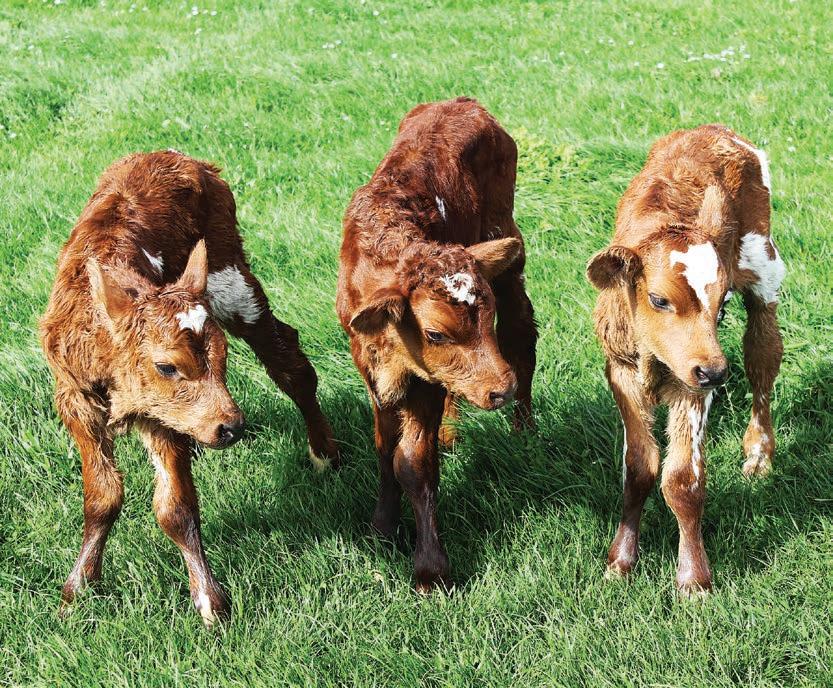
It was a case of three for the price of one in Woodville this season after one of the girls gave birth to triplet calves.
But the fun didn’t stop there on
Sunshine Ayrshires, with several other cows having twins. We reckon there must be something in the water, but owner Bob Lawson puts it down to good genetics and careful management.
The triple surprise arrived on
September 29. Lawson says the first one calved on its own but the second calf was having difficulties.
“I had a feel around and could tell the calf’s head was twisted back, so didn’t muck around and called Vet Services
Dannevirke,” he says.
“They came and calved her then the vet said she would have a feel around to make sure everything was okay. When she told me there was another, I was gobsmacked.”
Bob says that the triplets were a surprise even though the dam was
“huge” before she calved.
“We had a fair idea that she was in-calf with twins as she is a twin herself, but then for her to have triplets, well that was something else,” he says.
The pedigree Ayrshire dam was also their daughter Madison’s calf club calf from four years ago when she attended Papatawa School and won the Champion Calf title, meaning she was already a special cow.
Bob and wife Nikki are in their fifth year leasing the farm at Woodville where they milk about 175 pedigree Ayrshires, but he has been farming for 40 years and has never had triplets calves.
“I do recall mum and dad having a cow calve with triplets at the farm in Hamua near Eketahuna but in the years I have been farming, this is a first for me. It has been pretty exciting,” he says.
Last season we reported a set of triplets on a Northland farm and at the time, a Massey University associate professor said that the chances of a calving live triplets was “about one in two million.”
And the chances of a cow carrying triplets was about one in 500,000, but from there it was about a one in four chance that all three would be born alive.
But even rarer are quadruplets. Back in August we had reports of a set of quadruplet calves born on a Hauraki Plains farm. According to DairyNZ, a cow has a one in 700,000 chance to have four calves at once. The odds of all being born alive and being healthy are even lower at one in every 11.2 million.
However, the chances of all four being heifer calves, according to US data, are one in every 179.2m.
That’s what I call bang for your buck.
Sonita
Like us: farmersweekly.co.nz
Follow us: @DairyFarmer15 Read us anywhere: farmersweekly.co.nz
Dairy Diary S NOVEMBER 2020 M T W T F S November 2020 1 2 3 4 5 6 7 November 4 – DairyNZ Waikato Dairy Industry Awards open day. Sarah and Aidan Stevenson won the Waikato and National Share Farmers of the Year Award at this year’s Dairy Industry Awards. Come and see what makes the 8 15 9 16 10 17 11 18 12 19 13 20 14 21 Stevensons’ sharemilking business so successful. We will also be hearing from the winners of the Farm Trainee of the Year and Dairy Farm Manager of the Year. 22 23 24 25 26 27 28 Info at www.dairyevents.co.nz 29 30
November 5 – AgFirst
Project update on N-loss Mitigation Options. You are invited to attend a field day for the Sustainable Farming Fund project looking into controlled drainage and the treatment of drainage water on farms in Rural Support Trust – various dates and locations the Rangitikei and soon to be Tararua. Tony Christiansen is a world-leading motivational and inspirational Info at www.facebook.com/sffproject speaker. He is humorous, bold and straight talking as he brings you a November 17 and 26 – SMASH Spotlight on the System, Patea and Te Aroha. We will cover breeding to fit your goals, feeding your herd this summer and successful heifer management. Info at www.smallerherds.co.nz story you will never forget. Tony has no legs, a result of a horrific train accident when he was nine years old, yet has achieved remarkable feats in his life. He shares his life story and the secrets to his incredible success. Info at http://www.rural-support.org.nz/ or contact Wanda Leadbeater 021 180 2995 November 18-19 – DairyNZ The InCalf Foundations’ Waikato training course teaches participants how to use InCalf’s innovative resources and tools to help improve the reproductive performance of dairy herds. Info at www.dairyevents.co.nz DairyNZ – various dates and locations What are the key profit and environmental numbers for your business? DairyNZ, in conjunction with your dairy company, will be discussing the key profit and environmental numbers for your business to be future fit. We will provide the latest timelines relevant November 20 – DairyNZ to your business for environmental changes relating to He Waka Eke Tiller Talk in Manawatu. Topics at this group will include keeping Noa and Action for Healthy Waterways (Essential Fresh Water) policy. quality and managing residuals, and grass silage. This group is a small Info at www.dairyevents.co.nz group of like-minded farmers supported by partner agronomists to provide technical expertise. Info at www.dairyevents.co.nz Dairy Business of the Year – various dates and locations Free on-farm field days. This is an excellent opportunity to hear and learn from some of New Zealand’s most resilient, sustainable and November 24 – BFA innovative dairy farmers. Agri Talk 2020, Taupo, is an interactive seminar covering issues farmers Registration and more info at www.dboy.co.nz/page/field-days/ are facing and providing a risk rating for your business. We’ve teamed up with specialist partners to cover off topical issues that may keep you awake at night, focusing on topics to help you manage risk and reduce stress for you and your family. Register at bfa.co.nz/agritalk Thriving Farming Women – various dates and locations Taking Time to Thrive workshops are purposely designed for farming women to help inspire and motivate. Facilitator Loshni Manikam, who is also a farming woman has set-up Thriving Farming Women to help other women identify and overcome the hurdles that get in the way of November 25 – Owl Farm them thriving. Owl Farm focus day. Update on the season to date for Owl Farm plus The event has been fully funded, so tickets are free but bookings are seasonally relevant topics. essential. Info at https://www.owlfarm.nz/ Contact Wanda Leadbeater 021 180 2995 November 30 – December 2, DairyNZ Dairy Women’s Network – various dates and locations A three-day practical and interactive workshop designed to give you Your farm business future, ASB and NZ CA Limited are proud to deliver the skills to deliver the Healthy Hoof programme to your farming this workshop focused on succession planning and preparing the next clients generation into farming and farm ownership. Internationally recognised lameness expert Neil Chesterton delivers classroom and on-farm training on lameness theory, observing cow flow and herd management, treating lame cows, track and shed design, and conducting a lameness investigation. Info at www.dairyevents.co.nz Dairy Women’s Network – various dates and locations NAIT and OSPRI are proud to deliver this interactive workshop on the fundamentals of NAIT. Info at www.dwn.co.nz/events











